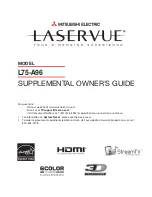
Circuit Descriptions, Abbreviation List, and IC Data Sheets
9.
The Tuner (item 1200) is a PLL tuner and delivers the IF-signal,
via audio and video SAW-filters, to the HIP (High-end Input
Processor). The HIP has the following functions:
•
IF modulation.
•
Video source select and record select.
•
Color decoder.
•
Synchronization.
Several video input/output connections (with audio
connections) are available:
1.
Side I/O: interfaces CVBS, SVSH.
2.
AV1: interfaces CVBS, RGB-input and YUV-input (1fH)
3.
AV2: interfaces CVBS and Y/C (meant for VCR-
connection).
4.
AV4: interfaces YPbPr/RGB (HD) inputs (2fH).
5.
Monitor out: interfaces CVBS out.
6.
Audio out: interfaces external front and surround speakers.
The HIP delivers YUV and sync signals to the PICNIC. This IC
takes care of:
•
Analog to Digital conversion and vice versa.
•
Interlaced to progressive scan conversion.
•
Panorama mode.
•
Noise reduction.
•
Dynamic contrast.
For Digital Scan, the PROZONIC is required, which can be
connected to the PICNIC.
After the PICNIC, the YUV signals and sync signals are fed to
the HOP (High-end Output Processor). This IC handles the
video control and geometry part. The RGB-signals for CC/OSD
(from the uP) are also inserted via the HOP. The video part
delivers the RGB signals to the CRT-panel and the geometry
part delivers the H-drive, V-drive, E/W-drive, and TILT-drive
signals.
Both deflection circuits are 'hot' and located on the LSP. The
HOP drives them. To make a galvanic separation, the Line
Drive is driven via transformer 5410 and the Frame Drive via
transformer 5621.The horizontal output stage generates some
supply voltages and the EHT voltage, focus voltage and Vg2
voltage.
The RGB amplifiers on the CRT-panel are integrated in one IC,
and are supplied with 200 V from the LOT.
The Scavem circuit modulates transitions of the Luminance (Y)
signal on the horizontal deflection current, giving a sharper
picture.
The sound part is built around the MSP34xx (Multi-channel
Sound Processor) for IF sound detection, sound control and
source selection. Dolby decoding is also done by the MSP.
Amplification is done via a 'class B' integrated power amplifier
IC, the TDA7497.
The microprocessor ('Painter') takes care of the analog CC
input processing and output processing. The
µ
P, ROM, and
RAM are supplied with 3.3 V, which is derived from the +5V2.
The NVM (Non Volatile Memory) is used to store the settings,
the Painter is an OTP (One Time Programmable) chip with
integrated set software.
There is a separate Standby Supply, in order to reduce the
Standby power consumption. During Standby, the Main Supply
is switched 'off' (via TS7529). A relay (1550) is used to switch
the Degaussing circuit. It is switched 'on' after set start-up and
switched 'off' by the
µ
P after 12 s.
The Main Supply, a SMPS based on the 'boost converter'
principle, generates the 141 V (VBAT) and the +28V for the
audio part.
Note: Voltage VBAT is not mains isolated ('hot'), but is
alignment free.
9.3
Power Supply (Diagram A1 and A2)
The power supply has a number of main functions:
1.
Mains harmonic filter.
2.
Degaussing picture tube.
3.
Standby power supply.
4.
Main supply.
9.3.1
Mains Harmonic Filter (Diagram A1)
Figure 9-2 Mains harmonic filter
The mains harmonic filter has two functions: to prevent high
frequency signals (harmonics) from being transferred into the
mains and to protect the set from lightning damage.
Capacitor C2507 prevents the high frequency signals
(generated by the set), from being conveyed into the mains (it
forms a short-circuit).
In case of a lightning surge between the 2 phases (differential
mode), the energy is immediately bled away through the VDR
(R3509) to the other phase.
In case of a lightning surge on both phases of the mains in
relation to the aerial ground (common mode), the filter acts as
a high resistance (U
EMK
= L * dI/dt), as a result of which the
voltage across coil L5503/04 increases. A spark gap (1590)
prevents the voltage from increasing too much, which would
lead to a damaged coil. When ignited, the current will be
discharged via this spark gap.
Resistor R3500 is used for limiting the inrush-current.
9.3.2
Degaussing (Diagram A1)
As soon as the set is connected with the AC Power, the 5V2 is
present. When the 'DEGAUSSING' signal from the processor
(Painter) is 'low,' transistor 7528 will conduct, and relay 1550 is
activated. Initially a considerable current will flow, via PTC
3516, through the degaussing coil. The PTC will heat up,
resistance will rise, and the current will decay rapidly. The
Painter makes the 'DEGAUSSING' signal 'high' after 12
seconds, which will switch 'off' the relay.
9.3.3
Standby power supply (Diagram A2)
Principle
This power supply is not only delivering the standby voltage,
but also the main voltages for the small signal part. It is a SOPS
type (Self-Oscillating Power Supply) and is regulated by the
controlled switching of an oscillator. It uses the 'Flyback'
principle:
CL 16532044_020.eps
140501
2507
mains
3521
4M7
1501
1590
3501
9503
Mains harmonic
diversity
3551
2
1
3
4
V
9504
9504
+375V
-
-
+
2516
2537
3500
5502
5511 or 5516
3
1
1
2
4
3
2
5503 or
5504
Summary of Contents for Chassis EM1.1A AA
Page 51: ...Circuit Diagrams and PWB Layouts 51 EM1 1A AA 7 Layout LSP Top Side ...
Page 53: ...Circuit Diagrams and PWB Layouts 53 EM1 1A AA 7 Layout LSP Overview Bottom Side ...
Page 54: ...54 EM1 1A AA 7 Circuit Diagrams and PWB Layouts Layout LSP Part 1 Bottom Side ...
Page 55: ...Circuit Diagrams and PWB Layouts 55 EM1 1A AA 7 Layout LSP Part 2 Bottom Side ...
Page 56: ...56 EM1 1A AA 7 Circuit Diagrams and PWB Layouts Layout LSP Part 3 Bottom Side ...
Page 57: ...Circuit Diagrams and PWB Layouts 57 EM1 1A AA 7 Layout LSP Part 4 Bottom Side ...
Page 126: ...Revision List EN 126 EM1 1A AA 11 11 Revision List First release ...
















































